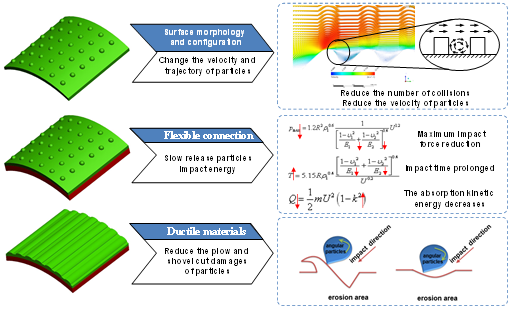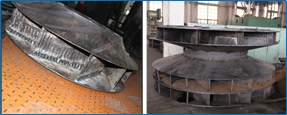It is found that typical desert organisms such as desert scorpion have excellent erosion resistance and cross-scale structural coupling rules under the dynamic action of heterogeneous mixed media. The influence mechanism of surface morphology, cross-scale structure and flexibility on the erosion resistance of desert scorpion were revealed.
Desert scorpion survive in the desert environment where wind-sand erosion occurs frequently. Through long-term natural selection and evolution, the variation unfavorable to wind-sand erosion was gradually eliminated and the variation favorable to wind-sand erosion was gradually accumulated. The back plate of desert scorpion has millimeter arc structure, convex hull and groove on the surface, flexible nodal membrane between the back plate, flexible side membrane between the back plate and the web, and chitin micron convex array structure on the back plate. These multi-factors combined with multi-scale structure and morphology make desert scorpion have excellent erosion resistance.

Figure 1 Living scorpion and its body surface structures. (a) Living scorpion, (b) Bump, (c) Grooved nodal membrane, (d) Flexible lateral membrane
As shown in figure 2, through systematic experimental study, scorpion body surface erosion resistance principle is the result of multi-factor and multi-element coupling synergistic effect, which can be divided into the following three mechanisms. 1. The effect of surface morphology and configuration: under the effect of different surface morphology (groove, convex hull and curved surface) of scorpion, the impact angle and relative velocity of impact particles and material surface change due to the surface of different morphology and matrix surface are at a certain angle. At the same time, vortices are formed in the grooves, which further reduce the velocity of the impact particles and reduce the number of the particles hit the material surface. 2. The function of flexible connection: there is a flexible membrane on the surface of scorpion, which can reduce the maximum impact force of impact particles, extend the impact time and absorb part of the impact energy. 3, The role of ductile materials: chitin film of scorpion body surface is a good toughness material, the improvement of material toughness can effectively reduce the plow and shovel cut damage of impact particles. Under the coupling effect of the above three factors, scorpion body surface has excellent erosion resistance.

Figure 2 The principle of erosion resistance of scorpion surface structure.
Current applications include agricultural machinery, garden machinery and general machinery. More than 10 enterprises in four provinces (heilongjiang, jilin, liaoning and shandong) have obtained application demonstration. Among them, the application of centrifugal fan has made a breakthrough progress. The bionic anti-erosion structure can be processed on the surface of the centrifugal fan blades, which can greatly improve the anti-erosion structure of fan blades. Compared with traditional fan blades, the erosion resistance of centrifugal fan blades with bionic structure was improved by 29%.

Figure 3 Application of bionic structures in centrifugal fan.
[1] Han, Z. et al. Erosion resistance of bionic functional surfaces inspired from desert scorpions. Langmuir 28, 2914–2921 (2012).
[2] Han, Z. et al. The effect of the micro-structures on the scorpion surface for improving the anti-erosion performance. Surf. Coatings Technol. 313, 143–150 (2017)
[3] Han, Z. et al. Erosion-resistant surfaces inspired by tamarisk. J. Bionic Eng. 10, 479–487 (2013).
[4] Han, Z. et al. Anti-erosion function in animals and its biomimetic application. J. Bionic Eng. 7, 50–58 (2010).
[5] Han, Z. et al. An Efficient Bionic Anti-Erosion Functional Surface Inspired by Desert Scorpion Carapace. Tribol. Trans. 58, 357–364 (2015).
[6] Han, Z. et al. Gas-solid erosion on bionic configuration surface. J. Wuhan Univ. Technol. Mater. Sci. Ed. 26, 305–310 (2011).
[7] Han, Z. et al. Active anti-erosion protection strategy in tamarisk (tamarix aphylla). Sci. Rep. 3, 1–7 (2013)
[8] Zhang, J. et al. The Ingenious Structure of Scorpion Armor Inspires Sand-Resistant Surfaces. Tribol. Lett. 65, 1–11 (2017).
[9] Zhang, J. Q. et al. Scorpion back inspiring sand-resistant surfaces. J. Cent. South Univ. 20, 877–888 (2013).
[10] Zhang, J. Q. et al. Numerical analysis of erosion caused by biomimetic axial fan blade. Adv. Mater. Sci. Eng. 2013, (2013).
[11] Yin, W. et al. Gas–Solid Erosive Wear of Biomimetic Pattern Surface Inspired from Plant. Tribol. Trans. 60, 159–165 (2017).
Zhiwu Han
